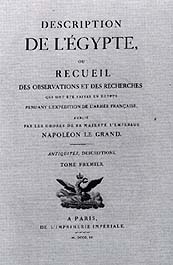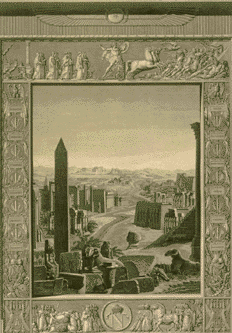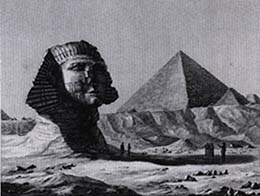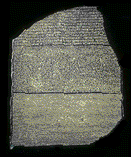NAPOLEON IN EGYPT: A SHORT ACCOUNT
This paper was delivered originally as a slide lecture.
The numbered notes refer to a list of the illustrations
included at the end, not to the additional illustrations included in the text.
The Napoleonic expedition to Egypt was the end result of attitudes and interests which had been nurtured for over a hundred years. As early as 1670, Leibnitz, in his paper Thoughts on Public Safety, contended that the states of Europe should not vie against one another but against the peoples of the non-Christian world. In his global plan domination of Egypt should fall to France, thus diverting France from aggression against its neighbor Germany. In a memorandum to Louis XIV of 1672, with a full discussion of his proposal, Leibnitz maintained that Egypt would be an appropriate acquisition as the cornerstone of a French empire and the advantages of its situation and the possibilities for control of a route to India were emphasized.
One hundred years later, in 1769, Louis XV was counciled by the Duc de Choiseul to replace the French colonial efforts in the Americas with the conquest of Egypt and, during the last decades of the eighteenth century the Ministry of Foreign Affairs was inundated with reports by voyagers, negociants and consular agents commissioned to report on the benefits to be derived from such a plan. As an example, in 1777 Baron de Tott was sent by the Foreign Office on a secret mission to explore the advantages of securing Egypt as a French colony. He was accompanied by Sonnini de Manincourt, a naturalist, among other specialists, who wrote his own summary of observations.
On the 12th of April, the Directory in secret, created the Army of the Orient, naming Bonaparte as Commander in Chief, with the aims of invading Egypt, defeating the English in the Eastern Mediterranean, and as an incidental adjunct, investigating the possibility of cutting a canal through the isthmus of Suez. On May 19 the major part of the expeditionary force had assembled and were embarked at Toulon. When joined by other forces from Genoa and Civitta Vecchia this would number almost 400 vessels, 55,000 men, over a thousand pieces of artillery, 567 vehicles and 700 horses. The French troops were not informed of their destination and were totally unprepared for desert warfare, even to the lack of proper footwear and water containers. Only about half of them would live to return to France at the close of the abortive campaign.
Clearly "as one says, it was a plan that was in the air", but General Bonapart, not yet thirty years old(1), added an aspect to the exercise which would make it far more than an ordinary invasion force. Attached to the army were about 500 civilians; of these 150 were artists, scientists, scholars, engineers and technicians. This group of Savants (known to the troops as "the donkeys"), was to make the expedition a turning point in the Western study of Egypt, its life, natural history and antiquity. the country, in its influence on the arts in Europe and, ultimately, in America.(2) The Description de l' Egypte(3) has been discussed in much detail elsewhere; it is enough to point out some of the varied uses to which the rich treasure of information and illustration have been put.
The Description de l' Egypte(3) has been discussed in much detail elsewhere; it is enough to point out some of the varied uses to which the rich treasure of information and illustration have been put. Until the publication of the Description the engravings in the eighteenth century works of the Dane, Norden, and the Englishman, Pococke, were the best views of the country and the preserved antiquities available.(4) The plates of the Description were to have a lasting influence on the western perception of Egypt. Some of the views suggest the landscape and come close to the effect of the tourist snapshot.(5) Often the artist who made the drawing from which the plates were engraved included himself or his associates in the scene. The hand measured here ended up in the collection of the British Museum after the French capitulation. Even general views of the monuments were accurate, as in this panorama of the pyramids at Giza with the Sphinx.(6) In the detail the inclusion of figures for scale adds a sense of the activity which would be lacking in plates without such a reference.(7) The image of the Sphinx drawn by Jacques Conte has a special interest because most of the plates for which he did the designs were descriptions of modern daily life.(8)
Until the publication of the Description the engravings in the eighteenth century works of the Dane, Norden, and the Englishman, Pococke, were the best views of the country and the preserved antiquities available.(4) The plates of the Description were to have a lasting influence on the western perception of Egypt. Some of the views suggest the landscape and come close to the effect of the tourist snapshot.(5) Often the artist who made the drawing from which the plates were engraved included himself or his associates in the scene. The hand measured here ended up in the collection of the British Museum after the French capitulation. Even general views of the monuments were accurate, as in this panorama of the pyramids at Giza with the Sphinx.(6) In the detail the inclusion of figures for scale adds a sense of the activity which would be lacking in plates without such a reference.(7) The image of the Sphinx drawn by Jacques Conte has a special interest because most of the plates for which he did the designs were descriptions of modern daily life.(8) Measured architectural details elevated the Description from the realm of scenic curousity.(9) This pair of views of the Grand Gallery in the Great Pyramid accurately captures the details of this remarkable piece of architecture in a way that no modern photograph has succeeded in doing. This engraving is still used in books on the pyramids because it was so successful.
Measured architectural details elevated the Description from the realm of scenic curousity.(9) This pair of views of the Grand Gallery in the Great Pyramid accurately captures the details of this remarkable piece of architecture in a way that no modern photograph has succeeded in doing. This engraving is still used in books on the pyramids because it was so successful.
Accurate depictions of the major monuments provide us with a view of their appearance as they were at the beginning of the nineteenth century, complete with the overburden of mud brick dwellings and the accumulation of debris, not yet excavated.(10) This is particularly true of the Temple of Luxor which was encumbered by houses and dove cotes well into the nineteenth century.(11) The colossal statues there provided the simple challenge of special excavation to determine whether they were seated or standing. The section drawing illustrated here is one of the first complete views of these important sculptures of Ramesses II.(12) A view from the rear of the temple gives us an additional indication of the amount of excavation needed to free the structure and expose it in the condition in which it may be seen today.(13)
More important for the Egyptological record were the number of monuments examined and drawn by the French which have been damaged, or which have disappeared completely. This view of Antaepolis(14) is a good example. Located between Assyut and Akhmim in Upper Egypt, this city had a long and important history. When the French recorded it they saw the remains of Ptolemaic structures which had been restored in the reign of Marcus Aurelius.(15) This graphic record is important because the temple was swept away by the waters of the Nile in 1821. The ruins of Antinoopolis(16) tell a similar story. Here the French saw a triumphal arch, a theatre and other monuments. The city, founded by Hadrian to honor Antinious, exists today only in traces.(17) At Asmunine the story is much the same.(18) These examples serve to record one of the most important contributions of the French expedition: the careful and detailed depiction of the monuments which, in many cases, no longer exist.
A second, and equally important aspect of the investigation of the monuments was the careful mapping and planning carried out by trained engineers and architects. The country was mapped for the first time with modern instruments and by a large body of experts. As an example, the map of the Valley of the Kings at Luxor(19) is the first map to give an accurate idea of the locations of the then-known tombs. Sections and plans of individual tombs(20) have been improved on since, but they still give an accurate record of their condition at the time.(21) Of particular interest is the map of the Temple of Karnak(22) which exhibits a high degree of accuracy and includes a number of clues to structures which have been further damaged or covered by greater accumulation of debris. The Precinct of Mut to the south(23) was encumbered by a considerable amount of overburden but a number of features are shown here which have only been re-excavated in the last ten years. In this area the artists of the expedition recorded only two pieces of sculpture. The first is this colossal statue(24) probably preserved in the engraving as a picturesque example of the nature of the ruins. The piece still exists(25) but it has been rolled over into a different position. Before 1820 Giovanni Belzoni had dispatched to London the head and one arm from this statue, which he had found nearby.(26) The second statue in the Mut precinct is still in place as it was engraved here.(27) Only recently was a small amount of clearance made to examine the belt buckle on the kilt(28) which determined that a name of Ramesses II still existed, giving at least a period for the re-use of the statue.
The plates of the Description record a number of aspects of the antiquities. Some of them are frankly of only curious interest.(29) Mummies have fascinated every traveler to Egypt and the subject of mummification attracts more notice than any other connected with the history of the country. In the time of the French expedition there were considerably more examples of mummified bodies available for examination and for study than there are today. The quality of the engravings in the final publication are exemplified by this plate which illustrates a Coptic tunic.(30) Dated to the 5th or 6th century A. D., this well preserved piece of textile serves to suggest the skills of both the draughtsman who drew it as well as the engraver's faithful attention in reproducing it. In these two details(31) from the tomb the French called "The tomb of the Harpers", actually the tomb of Ramesses III in the Valley of the Kings, we return to the act of recording antiquities which no longer exist. Since the time of the expedition these tomb paintings have been mutilated and we have to rely on the French engravings for some idea of their original appearance.
In the volume devoted to the "Modern State" there are a number of plates which detail the appearance of typical examples of different social and occupational types. This plate(32) shows a young Mamluk in his well-appointed house. A water color for this composition is preserved in the Bibliothetic National in Paris attesting to the fidelity of the engraver in following his model. The second type illustrated is a mariner, seemingly in his sea-side house, but seated on an inscribed fragment of ancient stone. Behind him on the wall is posted a copy of the proclamation issued by Napoleon explaining the intention of the French to rid the country of the Mamluks and return the government to the control of the Turkish Porte.
The French expedition has been called the "Birth of Egyptology" for very good reason. The examples cited of monuments recorded would suggest that the beginnings of accurate observation by trained scholars started with the French. One discovery made by soldiers preparing fortifications at Rosetta near the sea must stand as the single most important contribution to the advance of the understanding of ancient Egypt.(33) The Rosetta Stone, with its bilingual inscription, provided one of the key aids to the decipherment of the ancient language. Ceded to the English as a part of the terms of the French capitulation, it had already been copied and impressions of the inscription had been pulled by the simple expedient of inking the surface like a printing block. Copies were circulated to scholars in Europe even though the stone itself went to London. Many of the other antiquities collected by the French went to England, including a large granite sarcophagus which had been re-used in a mosque in Alexanderia, but some pieces were sent to France.(34) Of great interest is this block statue now in the Brooklyn Museum, a present from Napoleon to Josephine; it passed into the collection of Lord Amherst of Hackney, then to William Randolph Hearst, and ended its travels in an American Museum. It serves as a particular example of the interest in Napoleon in some real souvenirs of the campaign.
The Rosetta Stone, with its bilingual inscription, provided one of the key aids to the decipherment of the ancient language. Ceded to the English as a part of the terms of the French capitulation, it had already been copied and impressions of the inscription had been pulled by the simple expedient of inking the surface like a printing block. Copies were circulated to scholars in Europe even though the stone itself went to London. Many of the other antiquities collected by the French went to England, including a large granite sarcophagus which had been re-used in a mosque in Alexanderia, but some pieces were sent to France.(34) Of great interest is this block statue now in the Brooklyn Museum, a present from Napoleon to Josephine; it passed into the collection of Lord Amherst of Hackney, then to William Randolph Hearst, and ended its travels in an American Museum. It serves as a particular example of the interest in Napoleon in some real souvenirs of the campaign.
The French adventure in Egypt served to open the country to study and exploitation by the west on many levels. This Zodiac ceiling(35) drawn by French draughtsmen under almost insurmountable difficulties, became the subject of an international competition of acquisition. In this case the winners were French and the huge blocks of stone from the temple of Dendera eventually ended up in the Louvre. The spirit of collecting was rampant in the first quarter of the nineteenth century, each national group depending on their wits and abilities to obtain some vague permission from the government of Mohammed Ali. Belzoni,(36) mentioned in connection with the Precinct of Mut, was one of the most skillful engineers in the movement of large sculpture, and it is to his resourcefulness and determination that the British Museum owes many of its Egyptian treasures.
Others came to record and describe, if not to collect. With the development of photography, the first documents to rival the engravings in the Description were possible. One man like Maxime du Camp, traveling with Gustave Flaubert in 1850, or another like Francis Frith,(37) just a few years later, could provide an accurate view of the ancient monuments which would have taken the French artists and engineers much greater effort and time.
or another like Francis Frith,(37) just a few years later, could provide an accurate view of the ancient monuments which would have taken the French artists and engineers much greater effort and time.
The immediate effect on the arts of France in the early nineteenth century is best exemplified by the paintings produced to commemorate and publicize the events of the Egyptian campaign. One of the best known of these is The Pesthouse at Jaffa,(38) painted by Baron Gros in less than six months and exhibited at the Salon of 1804, only five years after the event it records. It is Napoleon's compassion that is stressed and his position as the moral and spiritual leader of the French that is underlined. General Murat Defeating the Turks at the Battle of Abu Qir(39) followed quickly in 1806. Murat commissioned the second painting, now in the Hall of Battles at Versailles, and the artist sought first hand accounts and the advice of participants in the battle to ensure accuracy. The victory of the French at Abu Qir was one of the clear cut triumphs in the Egyptian campaign. Ironically, Mohammad Ali, who eventually ruled Egypt, was the leader of an Albanian contingent, and among those who escaped capture by the French. The glorification of Napoleon and his generals could not have been better carried out that by Gros who substituted modern heroes for the Romans of his master, Jacques Louis David.
The English, naturally, took a different attitude to the exploits of the French, so it is a different Napoleon,(40) scurrying away from Egypt under the watchful eye of the Sphinx, that Cruickshank depicts in this illustration to a comic "life" of the emperor.
Illustrations
1. Gerome, "Napoleon in the City of the Dead, Cairo."
2. Grenier, "Napoleon in the King's Chamber of the Great Pyramid. "Colored engraving. Vivant Denon is standing in the group at the right, holding a portfolio of
drawings under his arm.
3. Description de l'Egypte, Title Page (Included in text)
4. Description de l'Egypte, Frontispiece (Included in text)
5. Description de l'Egypte, Antiquities, Vol. V. Plate 3,
Measuring a colossal hand
6. Description de l'Egypte, General view of the Pyramids
and Sphinx at Sunset
7. Description de l'Egypte, Measuring the Sphinx
8. Description de l'Egypte, Sphinx with soldiers in shadow (Included in text)
9. Description de l'Egypte, Antiquities, Vol. V. Plate 13,
Two views in the Grand Gallery of the Great Pyramid
10. Description de l'Egypte, Facade of the Temple of Dendera
11. Description de l'Egypte, First Pylon of Luxor Temple
12. Description de l'Egypte, Antiquities, Vol. III, Plate 15,
Cross section of excavation of the colossal statue.
13. Description de l'Egypte, Temple of Luxor from the rear.
14. Description de l'Egypte, View of Antaeopolis with temple
ruins from the rear.
15. Description de l'Egypte, View of Antaepolis with temple
from the front.
16. Description de l'Egypte, View of Antinoopolis, remains of
triumphal arch.
17. Description de l'Egypte, View of Antinoopolis, Corinthian
columns of a Roman temple.
18. Description de l'Egypte, View of Asmunine, Egyptian colonnade
19. Description de l'Egypte, Map: Valley of the Kings
20. Description de l'Egypte, Plans and cross-sections of Royal
Tombs
21. Description de l'Egypte, Plans and cross-sections of Royal
Tombs
22. Description de l'Egypte, Map: Karnak Temple Complex
23. Description de l'Egypte, Map: Precinct of Mut, South Karnak
24. Description de l'Egypte, Larger colossal statue in situ in
the Precinct of Mut
25. Photograph of colossal statue in situ in the Precinct of Mut
26. Head and Arm in the British Museum
27. Description de l'Egypte, Smaller colossal statue in situ in
the Precinct of Mut
28. Photograph of smaller statue in situ in the Precinct of Mut
29. Description de l'Egypte, Antiquities, Vol. II. Plate 49,
Colored Engraving of Mummy Heads
30. Description de l'Egypte, Antiquities, Vol V, Plate 5,
Coptic Garments
31. Description de l'Egypte, Antiquities, Vol. II, Plate 91,
Colored Engraving of the painting of Two Harpists from the tomb of Ramesses III
32. Description de l'Egypte, The Modern State, Vol. II, Plate D,
Young Mamluk; Alexandrine Seaman
33. The Rosetta Stone, British Museum (Included in text)
34. Block Statue, Brooklyn Museum 39.602
35. Description de l'Egypte, Zodiac Ceiling, Dendera Temple
36. Color Engraving, Belzoni's Transportation of the colossal head
37. Francis Frith, Photograph, Colossal statue at Abu Simble
38. The Pesthouse at Jaffa, Baron Gross
39. General Murat Defeating the Turks at Aboukir, Baron Gros
40. George Cruikshank, Bonaparte Leaving Egypt, Colored Engraving
Return to Previous Page